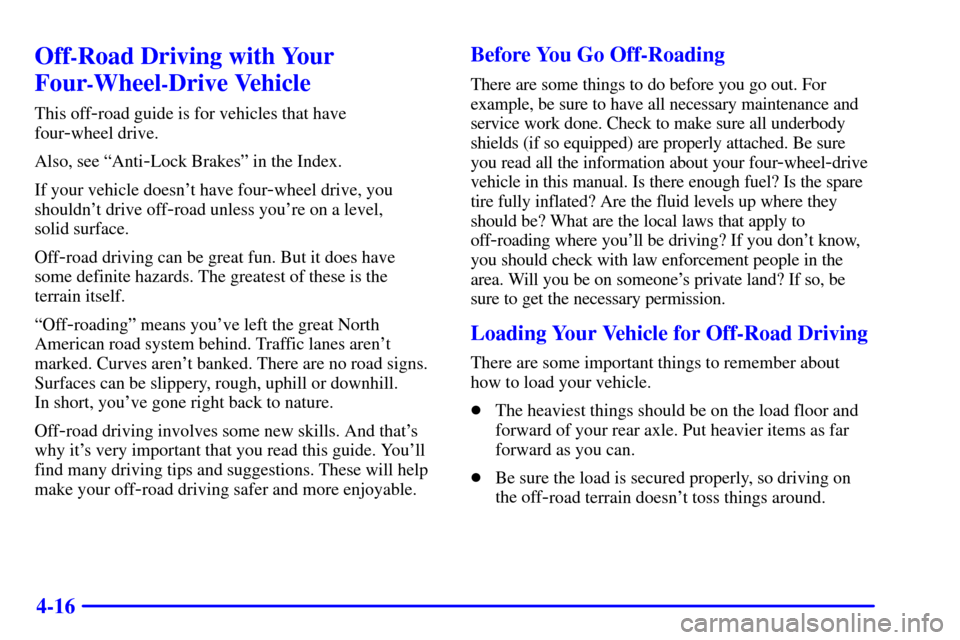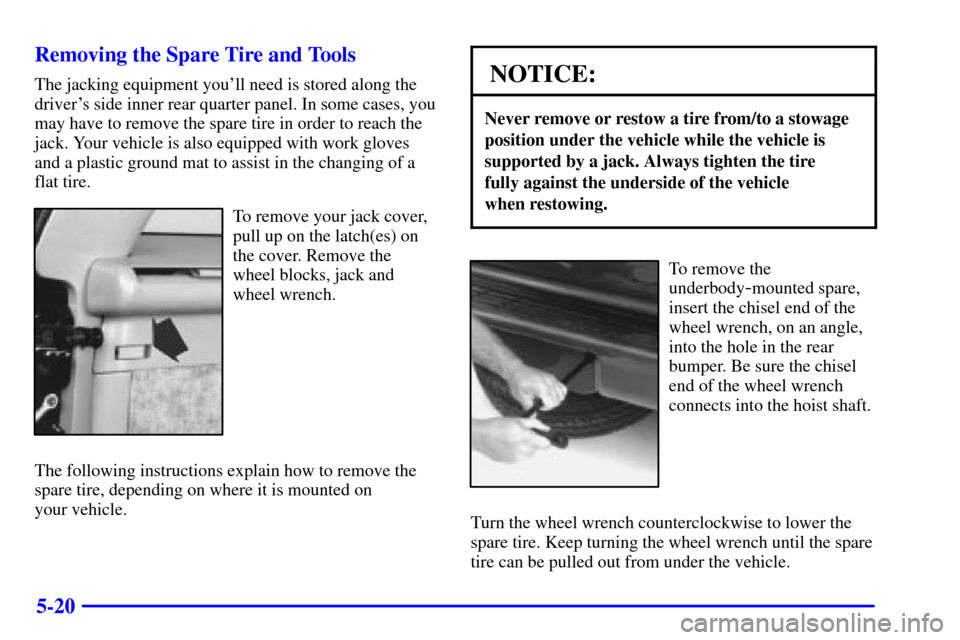Page 217 of 430

4-16
Off-Road Driving with Your
Four
-Wheel-Drive Vehicle
This off-road guide is for vehicles that have
four
-wheel drive.
Also, see ªAnti
-Lock Brakesº in the Index.
If your vehicle doesn't have four
-wheel drive, you
shouldn't drive off
-road unless you're on a level,
solid surface.
Off
-road driving can be great fun. But it does have
some definite hazards. The greatest of these is the
terrain itself.
ªOff
-roadingº means you've left the great North
American road system behind. Traffic lanes aren't
marked. Curves aren't banked. There are no road signs.
Surfaces can be slippery, rough, uphill or downhill.
In short, you've gone right back to nature.
Off
-road driving involves some new skills. And that's
why it's very important that you read this guide. You'll
find many driving tips and suggestions. These will help
make your off
-road driving safer and more enjoyable.
Before You Go Off-Roading
There are some things to do before you go out. For
example, be sure to have all necessary maintenance and
service work done. Check to make sure all underbody
shields (if so equipped) are properly attached. Be sure
you read all the information about your four
-wheel-drive
vehicle in this manual. Is there enough fuel? Is the spare
tire fully inflated? Are the fluid levels up where they
should be? What are the local laws that apply to
off
-roading where you'll be driving? If you don't know,
you should check with law enforcement people in the
area. Will you be on someone's private land? If so, be
sure to get the necessary permission.
Loading Your Vehicle for Off-Road Driving
There are some important things to remember about
how to load your vehicle.
�The heaviest things should be on the load floor and
forward of your rear axle. Put heavier items as far
forward as you can.
�Be sure the load is secured properly, so driving on
the off
-road terrain doesn't toss things around.
Page 280 of 430

5-20 Removing the Spare Tire and Tools
The jacking equipment you'll need is stored along the
driver's side inner rear quarter panel. In some cases, you
may have to remove the spare tire in order to reach the
jack. Your vehicle is also equipped with work gloves
and a plastic ground mat to assist in the changing of a
flat tire.
To remove your jack cover,
pull up on the latch(es) on
the cover. Remove the
wheel blocks, jack and
wheel wrench.
The following instructions explain how to remove the
spare tire, depending on where it is mounted on
your vehicle.
NOTICE:
Never remove or restow a tire from/to a stowage
position under the vehicle while the vehicle is
supported by a jack. Always tighten the tire
fully against the underside of the vehicle
when restowing.
To remove the
underbody
-mounted spare,
insert the chisel end of the
wheel wrench, on an angle,
into the hole in the rear
bumper. Be sure the chisel
end of the wheel wrench
connects into the hoist shaft.
Turn the wheel wrench counterclockwise to lower the
spare tire. Keep turning the wheel wrench until the spare
tire can be pulled out from under the vehicle.
Page 281 of 430
5-21
When the tire has been completely lowered, tilt the
retainer at the end of the cable and pull it through the
wheel opening. Pull the tire out from under the vehicle.
NOTICE:
To help avoid vehicle damage, do not drive the
vehicle before the cable is properly stored.
If you have an inside-mounted spare tire, the tire must
be removed in order to have access to the jack storage.
To remove an inside
-mounted spare tire, reach into your
tire's cover and unscrew the wing nut at the center of the
wheel. Remove it and the retainer. Unhook the tire from
the mounting bracket and remove the cover.
To remove a rear
-mounted spare tire, first make sure
that the carrier arm is fully
-latched to the endgate.
Then remove the spare tire cover.
The locking wheel nut can
be removed by snapping the
rubber weather cover off the
face of the lock case.
Insert the key and pull the
lock case straight off.
It is not necessary to turn
the key.
Put the spare tire near the flat tire.
Page 283 of 430
5-23
If you have individual wheel nut caps that cover each
nut, they must be removed in order to get to the wheel
nuts. Use the socket end of the wheel wrench to remove
the wheel nut caps.
Your wheel nut caps may attach your hub cap to the
wheel. Remove these wheel nut caps before you take off
the hub cap.
Removing the Flat Tire and Installing the
Spare Tire
1. Using the wheel wrench, loosen all the wheel nuts.
Don't remove them yet.
2. Turn the jack handle clockwise to raise the jack
lift head.
3. Fit the jack into the appropriate hole nearest the
flat tire.
Page 285 of 430
5-25
4. Raise the vehicle by turning the jack handle
clockwise. Raise the vehicle far enough off the
ground so there is enough room for the spare tire
to fit.
5. Remove all the wheel nuts and take off the flat tire.
6. Remove any rust or dirt
from the wheel bolts,
mounting surfaces and
spare wheel.
CAUTION:
Rust or dirt on the wheel, or on the parts to which
it is fastened, can make the wheel nuts become
loose after a time. The wheel could come off and
cause an accident. When you change a wheel,
remove any rust or dirt from the places where the
wheel attaches to the vehicle. In an emergency,
you can use a cloth or a paper towel to do this; but
be sure to use a scraper or wire brush later, if you
need to, to get all the rust or dirt off.
Page 286 of 430
5-26
CAUTION:
Never use oil or grease on studs or nuts. If you
do, the nuts might come loose. Your wheel could
fall off, causing a serious accident.
7. Place the spare on the wheel mounting surface.
8. Put the nuts on by
hand. Make sure
the rounded end is
toward the wheel.
Tighten each nut by hand until the wheel is held
against the hub. If a nut can't be turned by hand,
use the wheel wrench and see your dealer as soon
as possible.
Page 288 of 430
5-28
NOTICE:
Improperly tightened wheel nuts can lead to
brake pulsation and rotor damage. To avoid
expensive brake repairs, evenly tighten the wheel
nuts in the proper sequence and to the proper
torque specification.
Storing a Flat or Spare Tire and Tools
CAUTION:
Storing a jack, a tire or other equipment in the
passenger compartment of the vehicle could
cause injury. In a sudden stop or collision, loose
equipment could strike someone. Store all these
in the proper place.
Follow this diagram to store the
underbody
-mounted spare.
A. Retainer
B. Valve Stem
(Pointed Down)
C. Spare or Flat Tire
D. Spring
E. Wheel Wrench
F. Lower
G. Raise
H. Hoist Arm
Page 289 of 430
5-29
1. Put the tire on the ground at the rear of the vehicle,
with the valve stem pointed down and to the rear.
2. Pull the retainer through the wheel.
3. Put the chisel end of the wheel wrench, on an angle,
through the hole in the rear bumper and into the
hoist shaft.
4. Raise the tire fully against the underside of the
vehicle. Continue turning the wheel wrench until the
tire is secure and the cable is tight. The spare tire
hoist cannot be overtightened.
5. Make sure the tire is stored securely. Push, pull, and
then try to rotate or turn the tire. If the tire moves,
use the wheel wrench to tighten the cable.